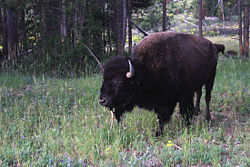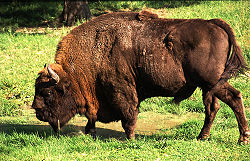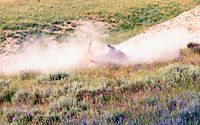Bison
- This is an article about an animal. For other uses, see Bison (disambiguation).
Bison is a taxonomic group containing six species of large even-toed ungulates within the subfamily Bovinae. Only two of these species still exist: the American bison (B. bison) and the European bison, or wisent (B. bonasus), each with two subspecies.
Name
In American Western culture, the bison is commonly referred to as "buffalo"; however, this is a misnomer: though both bison and buffalo belong to the Bovidae family, the term "buffalo" properly applies only to the Asian water buffalo and African buffalo. The gaur, a large, thick-coated ox found in Asia, is also known as the "Indian bison", although it is in the genus Bos and thus not a true bison.
The plural of "bison" is normally also "bison", not "bisons".
Description
The American and European bison are the largest terrestrial mammals in North America and Europe. Bison are nomadic grazers and travel in herds, except for the non-dominant bulls, which travel alone or in small groups during most of the year. American bison are known for living in the Great Plains. Both species were hunted close to extinction during the 19th and 20th centuries but have since rebounded, although the European bison is still endangered.
Unlike the Asian water buffalo, bison have never been domesticated, although the American bison is kept on some farms.
Bison are born without their trademark hump and horns and live for approximately twenty years. They grow to maturity at two to three years, although males continue to grow until about their seventh year. Adult bulls express a high degree of dominance competitiveness during mating season. Male bison fight for females and these fights often result in injury or death. After the bison mate, the herd splits up into smaller herds. Calves are born nine months after mating. The mothers take care of and nurse their young for a year.
Male bison grow to as much as to 11.5 feet (3.5m) long, and 6.5 feet (2m) tall at the shoulder and can weigh up to 2200lbs (998 kg).
Behavior
Wallowing
Wallowing is a common behavior of bison. A bison wallow is a shallow depression in the soil, either wet or dry. Bison roll in these depressions, covering themselves with mud or dust. Possible explanations suggested for wallowing behavior include grooming behavior associated with moulting, male-male interaction (typically rutting behavior), social behavior for group cohesion, play behavior, relief from skin irritation due to biting insects, reduction of ectoparasite load (ticks and lice), and thermoregulation.[1]
In the process of wallowing bison may become infected by the fatal disease anthrax, which may occur naturally in the soil.[2]
Diet
Bison have a fairly simple diet. The bison's main food is grass. Bison also eat the low lying shrubbery that is available. In the winter, bison forage in the snow looking for grass. If there is little grass available, bison have to resort to eating the twigs of the shrubs and plants.
Predators
Due to their large size few predators attack bison. Wolf packs, but not single wolves, could take down a bison. Brown bears will also prey on calves but when they are found eating bison they generally have driven off wolves and taken over their kill.

An American Bison standing its ground against a
wolf pack
In Yellowstone Park the strongest and most dominant wolf packs have been observed to take elk and deer; they leave the bison, which is much harder to kill, to the weaker wolf packs.
See also

Bison antiquus skeleton
- Bovid hybrids
- American Bison
- Plains Bison
- Wood Bison
- Ancient Bison
- Water Buffalo
- African Buffalo
- Buffalo (disambiguation page)
- Buffalo buffalo Buffalo buffalo buffalo buffalo Buffalo buffalo - a linguistic anomaly
Gallery
References
|
Extant Artiodactyla species |
|
| Kingdom: Animalia · Phylum: Chordata · Class: Mammalia · Infraclass: Eutheria · Superorder: Laurasiatheria |
|
|
Suborder Ruminantia |
|
| Antilocapridae |
|
Antilocapra
|
Pronghorn (A. americana)
|
|
|
| Giraffidae |
|
|
| Moschidae |
|
Moschus
|
Himalayan Musk Deer (M. chrysogaster) · Siberian Musk Deer (M. moschiferus) · Dwarf Musk Deer (M. berezovskii) · Black Musk Deer (M. fuscus)
|
|
|
| Tragulidae |
|
Hyemoschus
|
Water Chevrotain (H. aquaticus)
|
|
|
Moschiola
|
Indian Spotted Chevrotain (M. meminna) · M. kathygre
|
|
|
Tragulus
|
Java Mouse-deer (T. javanicus) · Lesser Mouse-deer (T. kanchil) · Greater Mouse-deer (T. napu) · Philippine Mouse-deer (T. nigricans) · Vietnam Mouse-deer (T. versicolor) · Williamson's Mouse-deer (T. williamsoni)
|
|
|
| Cervidae |
Large family listed below
|
|
| Bovidae |
Large family listed below
|
|
|
|
|
Family Cervidae |
|
| Muntiacinae |
|
Muntiacus
|
Indian Muntjac (M. muntjak) · Reeves's Muntjac (M. reevesi) · Hairy-fronted Muntjac (M. crinifrons) · Fea's Muntjac (M. feae) · Bornean Yellow Muntjac (M. atherodes) · Roosevelt's muntjac (M. rooseveltorum) · Gongshan muntjac (M. gongshanensis) · Giant Muntjac (M. vuquangensis) · Truong Son Muntjac (M. truongsonensis) · Leaf muntjac (M. putaoensis)
|
|
|
Elaphodus
|
Tufted deer (E. cephalophus)
|
|
|
| Cervinae |
|
Cervus
|
Red Deer (C. elaphus) · Elk (C. canadensis) · Thorold's deer ( C. albirostris) · Sika Deer ( C. nippon) · Barasingha ( C. duvaucelii) · Eld's Deer ( C. eldii) · Sambar Deer ( C. unicolor) · Rusa Deer ( C. timorensis) · Philippine Sambar ( C. mariannus) · Philippine Spotted Deer ( C. alfredi)
|
|
|
Axis
|
Chital (A. axis) · Hog deer (A. porcinus) · Calamian Deer (A. calamianensis) · Bawean Deer (A. kuhlii)
|
|
|
Elaphurus
|
Père David's Deer (E. davidianus)
|
|
|
Dama
|
Fallow Deer (D. dama) · Persian fallow deer (D. mesopotamica)
|
|
|
| Hydropotinae |
|
Hydropotes
|
Water deer (H. inermis)
|
|
|
| Odocoileinae |
|
Odocoileus
|
|
|
|
Blastocerus
|
Marsh Deer (B. dichotomus)
|
|
|
Ozotoceros
|
Pampas deer (O. bezoarticus)
|
|
|
Mazama
|
Red Brocket (M. americana) · Merida Brocket (M. bricenii) · Dwarf Brocket (M. chunyi) · Gray Brocket (M. gouazoubira) · Pygmy Brocket (M. nana) · Yucatan Brown Brocket (M. pandora) · Little Red Brocket (M. rufina)
|
|
|
Pudú
|
Northern Pudu (P. mephistophiles) · Pudú (P. pudu)
|
|
|
Hippocamelus
|
Taruca (H. antisensis) · South Andean Deer (H. bisulcus)
|
|
|
Capreolus
|
Roe Deer (C. capreolus) · Siberian Roe Deer (C. pygargus)
|
|
|
|
|
|
|
|
|
|
|
|
|
|
Family Bovidae |
|
| Cephalophinae |
|
Cephalophus
|
Abbott's Duiker (C. spadix) · Aders' Duiker (C. adersi) · Bay Duiker (C. dorsalis) · Black Duiker (C. niger) · Black-fronted Duiker (C. nigrifrons) · Blue Duiker (C. monticola) · Harvey's Duiker (C. harveyi) · Jentink's Duiker (C. jentinki) · Maxwell's Duiker (C. maxwellii) · Red Forest Duiker (C. natalensis) · Ogilby's Duiker (C. ogilbyi) · Peters's Duiker (C. callipygus) · Red-flanked Duiker (C. rufilatus) · Ruwenzori Duiker (C. rubidis) · Weyns's Duiker (C. weynsi) · White-bellied Duiker (C. leucogaster) · Yellow-backed Duiker (C. Sylvicultor) · Zebra Duiker (C. zebra)
|
|
|
Sylvicapra
|
Common Duiker (S. grimmia)
|
|
|
| Hippotraginae |
|
Hippotragus
|
Roan Antelope (H. equinus) · Sable Antelope (H. niger)
|
|
|
Oryx
|
East African Oryx (O. beisa) · Scimitar Oryx (O. dammah) · Gemsbok (O. gazella) · Arabian Oryx (O. leucoryx)
|
|
|
Addax
|
Addax (A. nasomaculatus)
|
|
|
| Reduncinae |
|
Kobus
|
Upemba Lechwe (K. anselli) · Waterbuck (K. ellipsiprymnus) · Kob (K. kob) · Lechwe (K. leche) · Nile Lechwe (K. megaceros) · Puku (K. vardonii)
|
|
|
Redunca
|
Southern Reedbuck (R. arundinum) · Mountain Reedbuck (R. fulvorufula) · Bohor Reedbuck (R. redunca)
|
|
|
| Aepycerotinae |
|
Aepyceros
|
Impala (A. melampus)
|
|
|
| Peleinae |
|
Pelea
|
Grey Rhebok (P. capreolus)
|
|
|
| Alcelaphinae |
|
Beatragus
|
Hirola (B. hunteri)
|
|
|
Damaliscus
|
Korrigum (D. korrigum) · Common Tsessebe (D. lunatus) · Bontebok (D. pygargus) · Bangweulu Tsessebe (D. superstes)
|
|
|
Alcelaphus
|
Hartebeest (A. buselaphus) · Red Hartebeest (A. caama) · Lichtenstein's Hartebeest (A. lichtensteinii)
|
|
|
Connochaetes
|
Black Wildebeest (C. gnou) · Blue Wildebeest (C. taurinus)
|
|
|
| Pantholopinae |
|
Pantholops
|
Tibetan antelope (P. hodgsonii)
|
|
|
| Caprinae |
Large subfamily listed below
|
|
| Bovinae |
Large subfamily listed below
|
|
| Antilopinae |
Large subfamily listed below
|
|
|
|
|
Family Bovidae (subfamily Caprinae) |
|
|
Ammotragus
|
Barbary Sheep (A. lervia)
|
|
|
Budorcas
|
Takin (B. taxicolor)
|
|
|
Capra
|
Wild Goat (C. aegagrus) · West Caucasian Tur (C. caucasia) · East Caucasian Tur (C. cylindricornis) · Markhor (C. falconeri) · Alpine Ibex (C. ibex) · Nubian Ibex (C. nubiana) · Spanish Ibex (C. pyrenaica) · Siberian Ibex (C. sibirica) · Walia Ibex (C. walie)
|
|
|
Hemitragus
|
Nilgiri Tahr (H. hylocrius) · Arabian Tahr (H. jayakari) · Himalayan Tahr (H. jemlahicus)
|
|
|
Naemorhedus
|
Red Goral (N. baileyi) · Japanese Serow (N. crispus) · Long-tailed Goral (N. caudatus) · Gray Goral (N. goral) · Mainland Serow (N. sumatraensis) · Taiwan Serow (N. swinhoei)
|
|
|
Oreamnos
|
Mountain goat (O. americanus)
|
|
|
|
|
|
|
Ovis
|
Argali ( O. ammon) · Domestic sheep (O. aries) · Bighorn Sheep ( O. canadensis) · Dall Sheep ( O. dalli) · Mouflon ( O. musimon) · Snow sheep ( O. nivicola) · Urial ( O. orientalis) |
|
|
Pseudois
|
Bharal (P. nayaur) · Dwarf Blue Sheep (P. schaeferi)
|
|
|
Rupicapra
|
|
|
|
|
|
Family Bovidae (subfamily Bovinae) |
|
| Boselaphini |
|
Tetracerus
|
Four-horned Antelope (T. quadricornis)
|
|
|
Boselaphus
|
Nilgai (B. tragocamelus)
|
|
|
| Bovini |
|
Bubalus
|
|
|
|
Bos
|
|
|
|
Pseudonovibos
|
Kting Voar (P. spiralis)
|
|
|
Pseudoryx
|
Saola (P. nghetinhensis)
|
|
|
Syncerus
|
African Buffalo (S. caffer)
|
|
|
Bison
|
|
|
|
| Strepsicerotini |
|
Tragelaphus
|
Sitatunga ( T. spekeii) · Nyala ( T. angasii) · Bushbuck ( T. scriptus) · Mountain Nyala ( T. buxtoni) · Lesser Kudu ( T. imberbis) · Greater Kudu ( T. strepsiceros) · Bongo (T. eurycerus) |
|
|
Taurotragus
|
Common Eland (T. oryx) · Giant Eland (T. derbianus)
|
|
|
|
|
|
Family Bovidae (subfamily Antilopinae) |
|
| Antilopini |
|
Ammodorcas
|
Dibatag (A. clarkei)
|
|
|
Antidorcas
|
Springbok (A. marsupialis)
|
|
|
Antilope
|
Blackbuck (A. cervicapra)
|
|
|
|
Mountain Gazelle (G. gazella) · Neumann's Gazelle (G. erlangeri) · Speke's Gazelle (G. spekei) · Dorcas Gazelle (G. dorcas) · Saudi Gazelle (G. saudiya) · Chinkara (G. bennettii) · Thomson's Gazelle (G. thomsonii) · Red-fronted Gazelle (G. rufifrons) · Dama Gazelle (G. dama) · Grant's Gazelle (G. granti) · Soemmerring's Gazelle (G. soemmerringii) · Cuvier's Gazelle (G. cuvieri) · Rhim Gazelle (G. leptoceros) · Goitered Gazelle (G. subgutturosa)
|
|
|
Litocranius
|
Gerenuk (L. walleri)
|
|
|
Procapra
|
Mongolian gazelle (P. gutturosa) · Goa (P. picticaudata) · Przewalski's Gazelle (P. przewalskii)
|
|
|
| Saigini |
|
Pantholops
|
Tibetan antelope (P. hodgsonii)
|
|
|
Saiga
|
Saiga Antelope (S. tatarica)
|
|
|
| Neotragini |
|
Dorcatragus
|
Beira (D. megalotis)
|
|
|
Madoqua
|
Günther's Dik-dik (M. guentheri) · Kirk's Dik-dik (M. kirkii) · Silver Dik-dik (M. piacentinii) · Salt's Dik-dik (M. saltiana)
|
|
|
Neotragus
|
Bates's Pygmy Antelope (N. batesi) · Suni (N. moschatus) · Royal Antelope (N. pygmaeus)
|
|
|
Oreotragus
|
Klipspringer (O. oreotragus)
|
|
|
Ourebia
|
Oribi (O. ourebi)
|
|
|
Raphicerus
|
Steenbok (R. campestris) · Cape Grysbok (R. melanotis) · Sharpe's Grysbok (R. sharpei)
|
|
|
|
|
|
Suborder Suina |
|
| Suidae |
|
Babyrousa
|
Buru Babirusa (B. babyrussa) · North Sulawesi Babirusa (B. celebensis) · Togian Babirusa (B. togeanensis)
|
|
|
Hylochoerus
|
Giant forest hog (H. meinertzhageni)
|
|
|
Phacochoerus
|
Desert Warthog (P. aethiopicus) · Warthog (P. africanus)
|
|
|
Porcula
|
Pygmy Hog (P. salvania)
|
|
|
Potamochoerus
|
Bushpig (P. larvatus) · Red River Hog (P. porcus)
|
|
|
|
Bearded Pig ( S. barbatus) · Indo-chinese Warty Pig ( S. bucculentus) · Visayan Warty Pig ( S. cebifrons) · Celebes Warty Pig ( S. celebensis) · Flores Warty Pig ( S. heureni) · Oliver's Warty Pig ( S. oliveri) · Philippine Warty Pig ( S. philippensis) · Boar (S. scrofa) · Timor Warty Pig ( S. timoriensis) · Javan Pig ( S. verrucosus) |
|
|
| Tayassuidae |
|
Tayassu
|
White-lipped Peccary (T. pecari)
|
|
|
Catagonus
|
Chacoan Peccary (C. wagneri)
|
|
|
Pecari
|
Collared Peccary (P. tajacu) · Giant Peccary (P. maximus)
|
|
|
|
|
|
|
|
|
Cetartiodactyla (unranked clade, higher than Artiodactyla) |
|
|
|
|
|




